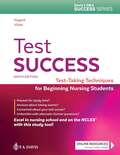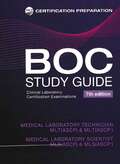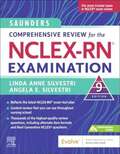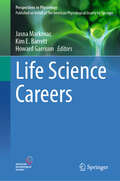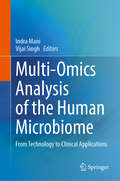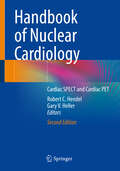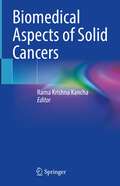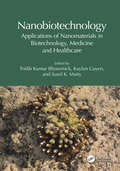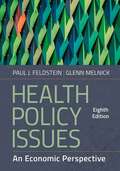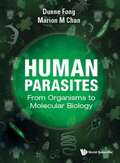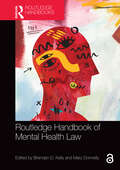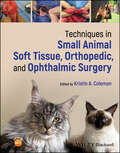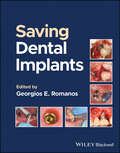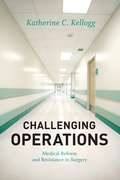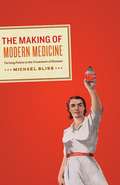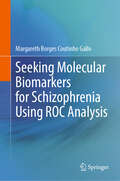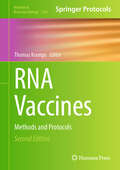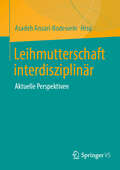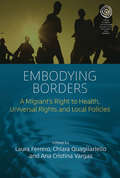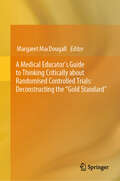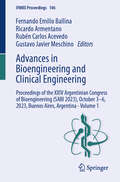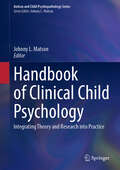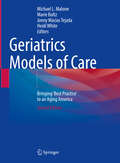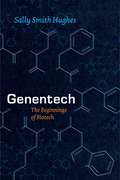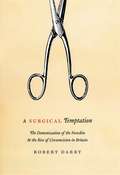- Table View
- List View
Test Success: Test-taking Techniques For Beginning Nursing Students
by Patricia M. Nugent Barbara A. VitaleBuild confidence and improve test scores. Success in nursing school starts here. A complete review of core concepts 900 questions (Alternate format, too!) Test-taking hints and rationales for correct and incorrect answers A complete review of core concepts, plus 900 questions based on the latest NCLEX© test plan build confidence and improve test scores from the beginning of nursing school. Master tricky alternate-format questions, even SATA (select all that apply), and develop efficient studying skills with test-taking tips and rationales for correct and incorrect responses. Purchase this title NEW and get 150 additional questions online plus all of the questions in the book.
Boc Study Guide Clinical Laboratory: Medical Laboratory Technician (mlt), Medical Laboratory Scientist (mls)
by Ascp Editorial BoardThe recently introduced 7th Edition of The Board of Certification Study Guide continues its long history as the authoritative study tool for preparing for the ASCP Board of Certification (BOC) Medical Laboratory Scientist (MLS) and Medical Laboratory Technician (MLT) certification examinations. When used together as a bundle with the BOC Interactive Practice Exam, Quick Compendium of Medical Laboratory Sciences and MLS Online Review Course, you will have a comprehensive suite of materials to prepare for the MLS/MLT certification examination. This new 7th edition includes hundreds of new questions and dozens of updated and revised questions from the previous edition to make this study tool state of the art. Concise and condensed, this new ASCP Study Guide 7th Edition is perfectly tailored for study according to the current BOC content outlines for the MLS and MLT exams.
Saunders Comprehensive Review For The Nclex-rn® Examination
by Linda Anne Silvestri Angela SilvestriPrepare for success on the NCLEX-RN® exam with this complete review! Often called the best NCLEX® exam review book ever, Saunders Comprehensive Review for the NCLEX-RN® Examination reviews all nursing content areas related to the current test plan. This new edition includes 5,700 NCLEX exam-style questions in the book and online, including alternate items formats and Next Generation NCLEX questions. Don't make the mistake of assuming the quality of the questions is the same in all NCLEX exam review books, because only this book includes the kinds of questions that consistently test the clinical judgment skills necessary to pass today's NCLEX exam. Even better, all answers include detailed rationales to help you learn from your answer choices as well as test-taking strategies with tips on how to best approach each question. Written by the most trusted names in NCLEX review, Linda Anne Silvestri and Angela Elizabeth Silvestri, this is THE book of choice for NCLEX preparation. But don’t just take our word for it ― read any customer review or ask your classmates to see why there's nothing else like it!
Life Science Careers (Perspectives in Physiology)
by Jasna Markovac Kim E. Barrett Howard GarrisonThis book is written for the many Life Science PhD students who may pursue careers outside of academic research. Even though the biggest portion of students will ultimately pursue other paths, university education trains them mostly for the academic track. Students often miss information, resources, contacts, or opportunities to explore other options. In response, the editors assembled a diverse group of authors from all fields related to Life Science research. The chapters offer a peek behind the curtain of each industry and offer guidance on how to move towards such roles. Through a high level of uniformity, students will get a plethora of career stories, each providing job opportunities, job descriptions, resources, and useful contact information. The purpose of this volume is to illustrate the many excellent opportunities that are available to life science PhDs, which will still allow them to make significant contributions to science.
Multi-Omics Analysis of the Human Microbiome: From Technology to Clinical Applications
by Vijai Singh Indra ManiThis book introduces the rapidly evolving field of multi-omics in understanding the human microbiome. The book focuses on the technology used to generate multi-omics data, including advances in next-generation sequencing and other high-throughput methods. It also covers the application of artificial intelligence and machine learning algorithms to the analysis of multi-omics data, providing readers with an overview of the powerful computational tools that are driving innovation in this field. The chapter also explores the various bioinformatics databases and tools available for the analysis of multi-omics data. The book also delves into the application of multi-omics technology to the study of microbial diversity, including metagenomics, metatranscriptomics, and metaproteomics. The book also explores the use of these techniques to identify and characterize microbial communities in different environments, from the gut and oral microbiome to the skin microbiome and beyond. Towards theend, it focuses on the use of multi-omics in the study of microbial consortia, including mycology and the viral microbiome. The book also explores the potential of multi-omics to identify genes of biotechnological importance, providing readers with an understanding of the role that this technology could play in advancing biotech research. Finally, the book concludes with a discussion of the clinical applications of multi-omics technology, including its potential to identify disease biomarkers and develop personalized medicine approaches. Overall, this book provides readers with a comprehensive overview of this exciting field, highlighting the potential for multi-omics to transform our understanding of the microbial world.
Handbook of Nuclear Cardiology: Cardiac SPECT and Cardiac PET
by Gary V. Heller Robert C. HendelThis extensively revised edition of this important textbook provides a practical approach to the use of nuclear cardiology for the general cardiologist. It is an adjunct to the existing literature in nuclear cardiology, providing a simple case-based approach to understanding the methodology, application and outcomes of the modality, and representing a pocket-sized compendium designed for a clinical cardiology audience. Nuclear cardiology procedures have been a mainstay in noninvasive testing for the diagnosis and risk stratification of coronary artery disease for many years. Although a mature field with a multitude of clinical applications, the advances in the technology and imaging procedures have been remarkable and important to document.Handbook of Nuclear Cardiology: Cardiac SPECT and Cardiac PET reviews the important indications for choosing nuclear cardiology procedures and provides a description of the procedures themselves, including both SPECT and PET imaging protocols, as well as supplying readers with a the key readings resources. It emphasizes how noninvasive testing results can be used clinically and the appropriateness of such techniques using a concise and logical structure, vital for trainees, practicing physicians, nurses and technologists looking for a brief, up-to-date overview and reference volume for nuclear cardiology. It therefore represents an essential reference for a large number of cardiologists internationally looking for information in the field.
Biomedical Aspects of Solid Cancers
by Rama Krishna KanchaThis book offers an overview of the biological basis of 26 different solid cancers for scientists and oncologists to understand the clinical challenges. The book provides a quick, simplified, and updated review of the present genetic or genomic medicine era. With genetic and molecular details to enhance understanding of biological mechanisms underlying disease pathogenesis and treatment response, each chapter covers epidemiology, risk factors, classification, pathophysiology, genetics, and treatment of solid cancers.This book is a beginner’s guide for life sciences and medicine graduate students, fellows in training, biomedical sciences researchers, principal investigators, clinician-researchers and oncologists.
Nanobiotechnology: Applications of Nanomaterials in Biotechnology, Medicine and Healthcare
by Kalyan Gayen Tridib Kumar Bhowmick Sunil K. MaityThis book covers topics related to drug delivery, biomaterials, drug design, formulation development, nanoscience, and nanotechnology. It describes the fundamental concepts in nanotechnology and their different applications in biotechnology to solve engineering challenges and generate new areas of technological development. Nanobiotechnology: Applications of Nanomaterials in Biotechnology, Medicine, and Healthcare covers vast application areas that include medical science, material science, pharmaceutical science, and environmental science. Section 1 presents recent research updates on the different nanomaterials, which are promising in different medical and biotechnological applications. Applications of nanomaterials as bone replacement orthopedic implants have revolutionized the treatment of orthopedic surgery. Nanostructured polymeric materials have gained immense research attention as therapeutic carriers for the precise delivery of drugs at targeted sites. Nanocellulose is recognized as a promising green nanomaterial due to its renewability and abundance in nature. Scientific topics on the most recent scientific and technological advances and applications of different nanostructured materials are presented in this section. Section 2 focuses on the novel synthesis methods that are used extensively and are promising for large-scale production of inorganic and nanostructured materials. Section 3 covers the applications of nanotools in the treatment of different diseases, including cancers and genetic diseases. The increasing use of nanotechnology will bring changes in the manufacturing processes of nanomaterials. The applications of nanomaterials in the field of medical imaging and molecular detection are presented in section 4. This book will be useful for students, researchers, scientists, academicians, and industrial manufacturers to understand the importance and applicability of nanomaterials in the field of biotechnology and medical science.
Health Policy Issues: An Economic Perspective, Eighth Edition
by Paul J. Feldstein Glenn MelnickHealth Policy Issues: An Economic Perspective uses concise, topical chapters to provide a comprehensive overview of the forces influencing healthcare financing and delivery. Concerns over health equity and the rise in healthcare costs are just a few of the timely and vital issues that are discussed through the lens of economics. Each chapter includes a clear explanation of the topic, diagrams, and charts to aid comprehension, and a summary and discussion questions at the end. This eighth edition has been revised to reflect the most recent research and data, as well as changes in laws and government policies. A new chapter compares the US health system to those of five European countries. New and updated content includes coverage of: • Current Medicare proposals • COVID’s effect on medical services delivery • Medicaid effectiveness • Strategies for addressing the physician shortage • Affordable Care Act updates Health Policy Issues shows how the economic approach to healthcare policy is important not only for understanding the structural and dynamic forces pressing for change in healthcare but also for explaining why the health system has evolved to its current state.
Human Parasites: From Organisms To Molecular Biology (G - Reference,information And Interdisciplinary Subjects Ser.)
by Dunne Fong Marion M. ChanWhy does the World Health Organization (WHO) put emphasis on neglected tropical diseases (NTDs)? What are the NTDs? Are NTDs found in the United States? Is there any relationship between coronavirus disease 2019 (COVID-19) and NTDs? These are some of the questions being addressed in the book.The aim of this textbook is to introduce a modern synthesis on human parasites of medical importance. Species of parasitic protozoa and helminths are presented in detail, from history and discovery to aspects of genomes and molecular biology, together with life cycle, therapy, drug resistance, and case studies of parasitic diseases useful to the clinicians.
Routledge Handbook of Mental Health Law (Routledge Handbooks in Law)
by Brendan D. Kelly and Mary DonnellyMental health law is a rapidly evolving area of practice and research, with growing global dimensions. This work reflects the increasing importance of this field, critically discussing key issues of controversy and debate, and providing up-to-date analysis of cutting-edge developments in Africa, Asia, Europe, the Americas, and Australia.This is a timely moment for this book to appear. The United Nations’ Convention on the Rights of Persons with Disabilities (2006) sought to transform the landscape in which mental health law is developed and implemented. This Convention, along with other developments, has, to varying degrees, informed sweeping legislative reforms in many countries around the world. These and other developments are discussed here. Contributors come from a wide range of countries and a variety of academic backgrounds including ethics, law, philosophy, psychiatry, and psychology. Some contributions are also informed by lived experience, whether in person or as family members. The result is a rich, polyphonic, and sometimes discordant account of what mental health law is and what it might be.The Handbook is aimed at mental health scholars and practitioners as well as students of law, human rights, disability studies, and psychiatry, and campaigners and law- and policy-makers.
Techniques in Small Animal Soft Tissue, Orthopedic, and Ophthalmic Surgery
by Kristin A. ColemanPractical reference with tips and tricks for successfully performing common surgeries in small animal patients Designed to help general practitioners confidently perform surgery, Techniques in Small Animal Soft Tissue, Orthopedic, and Ophthalmic Surgery offers fast access to step-by-step procedures for the most common surgeries in small animal patients. This book discusses the relevant anatomy, brief pathophysiology, pre-operative considerations, potential complications, and treatment options and detailed techniques for a wide range of surgical procedures, as well as the equipment needed to perform them. Written by specialists from around the world, the 54 chapters each cover multiple treatment options or variations to techniques described in the literature, featuring soft tissue, orthopedic, and ophthalmic surgeries. Practical tips and tricks for success in the operating room applicable to technicians, general practitioners, and surgeons are included throughout the book. High-quality color photographs accompany the surgical descriptions, along with video clips demonstrating some of the techniques hosted on a companion website. Techniques in Small Animal Soft Tissue, Orthopedic, and Ophthalmic Surgery includes information on: Simple eyelid mass removal, steps for prolapsed third eyelid gland, surgery for successful entropion repair, and enucleation Brachycephalic obstructive airway syndrome in dogs and cats and various surgical interventions, how to address aural hematoma, pinnectomy, and total ear canal ablation and lateral bulla osteotomy Ventral bulla osteotomy, mandibulectomy, sialoadenectomy, thyroidectomy, unilateral cricoarytenoid lateralization, and peripheral lymph node extirpation Extracapsular suture stabilization for the cranial cruciate ligament-deficient stifle, medial patellar luxation repair, femoral head and neck ostectomy, and canine elbow dysplasia Limb amputation in companion animals, skin reconstruction options, digit amputation, gastropexy, gastrointestinal procedures, splenectomy, and liver biopsies And many more procedures! Techniques in Small Animal Soft Tissue, Orthopedic, and Ophthalmic Surgery covers common surgeries performed in general practice, giving general practitioners, veterinary students, and new surgeons practical tips and tricks from experienced surgeons in an easily referenced format.
Saving Dental Implants
by Georgios E. RomanosComprehensive, multidisciplinary approach to all aspects of dental implant maintenance, based on treatment outcomes Saving Dental Implants offers a complete reference to all factors in long-term success in dental implants. Taking an interdisciplinary approach, each chapter is written by leading experts in the field. The book examines treatment outcomes, provides advice on how to manage implants for long-term success, and supports clinicians in avoiding and managing peri-implant complications. The text presents global treatment approaches and concepts—established philosophies in practice for the last 20 years—and also looks to possible future management strategies. Designed to help clinicians apply the concepts in practice, the text also covers the pros and cons of implant therapy and the specifics of pre-implant diagnostics, treatment methodology, prosthetic concepts, and further maintenance visits. Featuring hundreds of high-quality color photographs to support the text, Saving Dental Implants covers topics such as: The anatomic features of peri-implant tissues, including clinical and histological information, and an evaluation of the studies using different implant systems and prosthetic concepts Diagnostic tools and procedures to make the proper diagnosis of peri-implant conditions, and microbiota of the peri-implant tissues and diagnostic opportunities for bacterial diagnosis Nanoparticles found in the peri-implant tissues from the implant placement, their loading, and their impact on peri-implant diseases The significance, applications, and limitations of bone grafting techniques to optimize the shape of the alveolar ridge New technologies for better treatment of peri-implant complicationsExamining the most current information and research on diagnosing, preventing, and managing peri-implant complications, Saving Dental Implants is a must-have practical reference for dental practitioners, specialists, and students who wish to help patients reach the best functional and esthetic outcomes.
Challenging Operations: Medical Reform and Resistance in Surgery
by Katherine C. KelloggIn 2003, in the face of errors and accidents caused by medical and surgical trainees, the American Council of Graduate Medical Education mandated a reduction in resident work hours to eighty per week. Over the course of two and a half years spent observing residents and staff surgeons trying to implement this new regulation, Katherine C. Kellogg discovered that resistance to it was both strong and successful—in fact, two of the three hospitals she studied failed to make the change. Challenging Operations takes up the apparent paradox of medical professionals resisting reforms designed to help them and their patients. Through vivid anecdotes, interviews, and incisive observation and analysis, Kellogg shows the complex ways that institutional reforms spark resistance when they challenge long-standing beliefs, roles, and systems of authority. At a time when numerous policies have been enacted to address the nation’s soaring medical costs, uneven access to care, and shortage of primary-care physicians, Challenging Operations sheds new light on the difficulty of implementing reforms and offers concrete recommendations for effectively meeting that challenge.
The Making of Modern Medicine: Turning Points in the Treatment of Disease
by Michael BlissAt the dawn of the twenty-first century, we have become accustomed to medical breakthroughs and conditioned to assume that, regardless of illnesses, doctors almost certainly will be able to help—not just by diagnosing us and alleviating our pain, but by actually treating or even curing diseases, and significantly improving our lives. For most of human history, however, that was far from the case, as veteran medical historian Michael Bliss explains in The Making of Modern Medicine. Focusing on a few key moments in the transformation of medical care, Bliss reveals the way that new discoveries and new approaches led doctors and patients alike to discard fatalism and their traditional religious acceptance of suffering in favor of a new faith in health care and in the capacity of doctors to treat disease. He takes readers in his account to three turning points—a devastating smallpox outbreak in Montreal in 1885, the founding of the Johns Hopkins Hospital and Medical School, and the discovery of insulin—and recounts the lives of three crucial figures—researcher Frederick Banting, surgeon Harvey Cushing, and physician William Osler—turning medical history into a fascinating story of dedication and discovery.Compact and compelling, this searching history vividly depicts and explains the emergence of modern medicine—and, in a provocative epilogue, outlines the paradoxes and confusions underlying our contemporary understanding of disease, death, and life itself.
Seeking Molecular Biomarkers for Schizophrenia Using ROC Analysis
by Margareth Borges Coutinho GalloSchizophrenia Spectrum Disorders (SSD) manifest multidimensionally, presenting a syndromic nature with several symptomatic domains. These are driven by dynamic systemic biological changes that unfold over the course of the disease. Thus far, the diagnosis is solely based on symptoms, which may be rather subjective, moving research toward the search for SSD biomarkers. This book presents a summary of the main hypotheses that have evolved over time to explain the pathophysiology of SSD and that have driven the discovery of associated biomarkers: neurotrophic, neurotransmitter, neuroendocrine, immune-inflammatory, nitrosative/oxidative stress, metabolic, and gut microbiota-brain axis. The book shows the most relevant research carried out in the last twelve years to develop predictive, diagnostic, theranostic or transdiagnostic models based on these biomarkers using the receiver operating characteristic curve (ROC) analysis. Chapters also discuss how the literature has addressed the development and/or addition of new discriminatory biomarkers to achieve robust and successful results. The book is rounded out with a step-by-step explanation on how to work on the MetaboAnalyst platform, including the meaning of the chosen statistics and how to interpret them in the results obtained. This book is a useful resource for students and scientists involved in the discovery of biomarkers for psychiatric disorders and other diseases.
RNA Vaccines: Methods and Protocols (Methods in Molecular Biology #2786)
by Thomas KrampsThis second edition volume expands on the previous edition with discussions of the latest technology and advancements in the development of RNA vaccines and proposed solutions on how to tackle currently unmet medical needs. The chapters in this book are organized into four parts and cover topics such as replication and non-replicating RNA vectors, formulation and delivery of RNA vaccines, and clinical and nonclinical development of RNA vaccines. Written in the highly successful Methods in Molecular Biology series format, chapters include introductions to their respective topics, lists of the necessary materials and reagents, step-by-step, readily reproducible laboratory protocols, and tips on troubleshooting and avoiding known pitfalls.Practical and comprehensive, RNA Vaccines: Methods and Protocols, Second Edition is a valuable resource for any researcher interested in learning more about this important and developing field.
Leihmutterschaft interdisziplinär: Aktuelle Perspektiven
by Asadeh Ansari-BodeweinDer vorliegende Band enthält eine Sammlung von Aufsätzen zum Thema Leihmutterschaft aus Blickrichtungen verschiedener Disziplinen, die allesamt jeweils an den aktuellen Forschungsstand anknüpfen. Das Buch wendet sich an Interessierte aller Fächer, die sich mit der kontrovers diskutierten Frage nach einer Liberalisierung von Leihmutterschaftsmodellen befassen und gibt dabei einen Einblick in die Grundlagen der Diskussion in den relevanten Fächern Philosophie, Psychologie, Soziologie, Rechtswissenschaft und Medizin.
Embodying Borders: A Migrant’s Right to Health, Universal Rights and Local Policies (EASA Series #41)
by Laura Ferrero, Chiara Quagliariello Ana Cristina VargasBased on extensive field research, the essays in this volume illuminate the experiences of migrants from their own point of view, providing a critical understanding of the complex social reality in which each experience is grounded. Access to medical care for migrants is a fundamental right which is often ignored. The book provides a critical understanding of the social reality in which social inequalities are grounded and offers the opportunity to show that right to health does not correspond uniquely with access to healthcare.
A Medical Educator's Guide to Thinking Critically about Randomised Controlled Trials: Deconstructing the "Gold Standard"
by Margaret MacDougallDrawing on the statistical and philosophical expertise of its authors, this book is designed to improve understanding and use of randomised controlled trials (RCTs) among health professionals. It is intended for use primarily by medical educators involved in teaching statistics and evidence-based medicine (EBM) to medical students, junior doctors and other health professionals. However, each of the chapters serves a wider range of interests, including the practical needs of physicians in interpreting research evidence to support clinical decision making and the teaching needs of philosophers of medicine who want to more fully appreciate how RCTs work in practice and provide engaging examples for their students. Rather than compete with the proliferating methodological literature on RCT designs, this book focuses on cultivating a healthy skepticism among developing health professionals to support critical appraisal of their own and published work on RCTs at a fundamental level, including through a more informed understanding of the place of subgroup analyses in sound statistical inference. Management of the positive predictive value in the statistical analysis of RCT findings is included as an important topic for contemporary medical curricula. In comparing RCTs with non-randomised studies, a search for empirical evidence for the superiority of RCTs is initiated, pointing to the need for further work to confirm what form this evidence should take.Medical educators will find a wealth of reasons to encourage their students to think more critically about how the RCT operates in practice as a gold standard.
Advances in Bioengineering and Clinical Engineering: Proceedings of the XXIV Argentinian Congress of Bioengineering (SABI 2023), October 3–6, 2023, Buenos Aires, Argentina - Volume 1 (IFMBE Proceedings #106)
by Ricardo Armentano Fernando Emilio Ballina Rubén Carlos Acevedo Gustavo Javier MeschinoThis book offers a timely snapshot of research, technologies and best practices in the broad area of bioengineering and clinical engineering. It reports on advances in biomechanics, biomedical image processing, biomaterials and tissue engineering. Further, it covers applications of artificial intelligence in biology and medicine, and instrumentation. Gathering the first volume of the proceedings of the XXIV Argentinian Congress of Bioengineering (SABI 2023), held on October 3–6, 2023, in Buenos Aires, Argentina - and organised by the Sociedad Argentina de Bioingeniería, this book provides an extensive source of information for both researchers and professionals in biomedical and clinical engineering.
Handbook of Clinical Child Psychology: Integrating Theory and Research into Practice (Autism and Child Psychopathology Series)
by Johnny L. MatsonThis comprehensive handbook explores the many issues affecting children’s physical and mental health. Its coverage spans a broad range of topics, exploring the history and foundations of clinical child psychology as well as the discipline’s theories, research base, ethical and legal implications, and diagnostic systems, including the NIMH’s Research Domain Criteria (RDoC). The handbook examines family risk factors for children (e.g., parental stress, divorce, and depression) and provides leading-edge reviews of cognitive variables (e.g., theories of memory, executive function, theories of intelligence, theory of mind and cognitive tempo). In addition, it describes methods of assessment, including checklists, interviews, and methods of treatment (e.g., cognitive behavior therapy, mindfulness, and family therapy). Chapters focus on assessment of specific diagnostic categories, such as depression, anxiety, selective mutism, ADHD, and pediatric topics, including chronic pain, childhood cancer, childhood obesity, and toilet training. Finally, the book addresses such emerging issues as gender diversity, social justice, cyberbullying, internet gaming disorder and the impact of COVID-19.Key areas of coverage include:Foundations of clinical child psychology.Cognition and clinical child psychology.Testing, assessment, and treatment methods in child psychology.Neurodevelopmental and pediatric disorders in childhood.Assessment and treatments for challenging behaviors in children.Assessment and treatments for psychopathologies in children. The Handbook of Clinical Child Psychology is a must-have resource for researchers, professors, graduate students, clinicians, therapists, and professionals in clinical child and school psychology, child and adolescent psychiatry, social work, public health, pediatrics as well as special education, developmental psychology, nursing, and all interrelated disciplines.
Geriatrics Models of Care: Bringing 'Best Practice' to an Aging America
by Heidi White Marie Boltz Michael L. Malone Jonny Macias TejadaFollowing the success of the previous edition, the second edition of Geriatrics Models of Care is the definitive resource for systems-based practice improvement for the care of older adults. Several new models of care have been published in the last eight years, new outcomes have emerged to better understand the impact of existing models, and with the rise of the Age-Friendly Health Systems movement, promoting organized efforts to prepare our health care settings for older individuals is of more importance than ever. The second edition is organized based on the practice setting along a continuum of care: hospital, transitions from hospital to home, outpatient settings, and the emergency department. This book also highlights long-term care models, which is an important part of the continuum of care for older Americans. Further, this edition features models that address the needs of vulnerable populations. This new section will describe a spectrum of programs for older adults who have Alzheimer’s disease or Parkinson’s disease. Other models describe best practices for older adults undergoing surgery or those who want to remain functioning independently in their home. A defining feature of this book is that each chapter follows a standard template: 1) the challenge which led to the model; 2) the patient population served; 3) core components of the intervention; 4) the role of interdisciplinary health professionals; 5) evidence to support the intervention; 6) lessons learned in the implementation and dissemination of the model; 7) implications for family caregivers, and communities (particularly underserved and diverse communities); and 8) how each model will provide care across the continuum during an entire episode of care. In addition, each chapter features a “call out” box with practical tips for implementing the model.
Genentech: The Beginnings of Biotech (Synthesis Ser.)
by Sally Smith HughesIn the fall of 1980, Genentech, Inc., a little-known California genetic engineering company, became the overnight darling of Wall Street, raising over $38 million in its initial public stock offering. Lacking marketed products or substantial profit, the firm nonetheless saw its share price escalate from $35 to $89 in the first few minutes of trading, at that point the largest gain in stock market history. Coming at a time of economic recession and declining technological competitiveness in the United States, the event provoked banner headlines and ignited a period of speculative frenzy over biotechnology as a revolutionary means for creating new and better kinds of pharmaceuticals, untold profit, and a possible solution to national economic malaise. Drawing from an unparalleled collection of interviews with early biotech players, Sally Smith Hughes offers the first book-length history of this pioneering company, depicting Genentech’s improbable creation, precarious youth, and ascent to immense prosperity. Hughes provides intimate portraits of the people significant to Genentech’s science and business, including cofounders Herbert Boyer and Robert Swanson, and in doing so sheds new light on how personality affects the growth of science. By placing Genentech’s founders, followers, opponents, victims, and beneficiaries in context, Hughes also demonstrates how science interacts with commercial and legal interests and university research, and with government regulation, venture capital, and commercial profits. Integrating the scientific, the corporate, the contextual, and the personal, Genentech tells the story of biotechnology as it is not often told, as a risky and improbable entrepreneurial venture that had to overcome a number of powerful forces working against it.
A Surgical Temptation: The Demonization of the Foreskin & the Rise of Circumcision in Britain
by Robert DarbyIn the eighteenth century, the Western world viewed circumcision as an embarrassing disfigurement peculiar to Jews. A century later, British doctors urged parents to circumcise their sons as a routine precaution against every imaginable sexual dysfunction, from syphilis and phimosis to masturbation and bed-wetting. Thirty years later the procedure again came under hostile scrutiny, culminating in its disappearance during the 1960s. Why Britain adopted a practice it had traditionally abhorred and then abandoned it after only two generations is the subject of A Surgical Temptation. Robert Darby reveals that circumcision has always been related to the question of how to control male sexuality. This study explores the process by which the male genitals, and the foreskin especially, were pathologized, while offering glimpses into the lives of such figures as James Boswell, John Maynard Keynes, and W. H. Auden. Examining the development of knowledge about genital anatomy, concepts of health, sexual morality, the rise of the medical profession, and the nature of disease, Darby shows how these factors transformed attitudes toward the male body and its management and played a vital role in the emergence of modern medicine.
